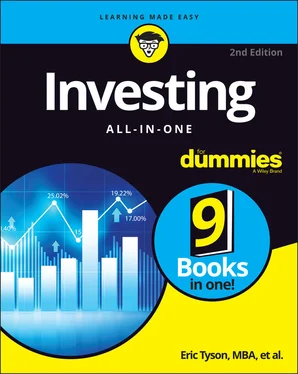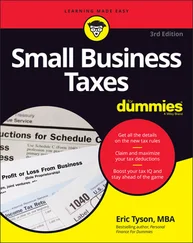Eric Tyson - Investing All-in-One For Dummies
Здесь есть возможность читать онлайн «Eric Tyson - Investing All-in-One For Dummies» — ознакомительный отрывок электронной книги совершенно бесплатно, а после прочтения отрывка купить полную версию. В некоторых случаях можно слушать аудио, скачать через торрент в формате fb2 и присутствует краткое содержание. Жанр: unrecognised, на английском языке. Описание произведения, (предисловие) а так же отзывы посетителей доступны на портале библиотеки ЛибКат.
- Название:Investing All-in-One For Dummies
- Автор:
- Жанр:
- Год:неизвестен
- ISBN:нет данных
- Рейтинг книги:3 / 5. Голосов: 1
-
Избранное:Добавить в избранное
- Отзывы:
-
Ваша оценка:
- 60
- 1
- 2
- 3
- 4
- 5
Investing All-in-One For Dummies: краткое содержание, описание и аннотация
Предлагаем к чтению аннотацию, описание, краткое содержание или предисловие (зависит от того, что написал сам автор книги «Investing All-in-One For Dummies»). Если вы не нашли необходимую информацию о книге — напишите в комментариях, мы постараемся отыскать её.
Investing All-in-One For Dummies
.
Dummies
Investing All-in-One For Dummies
Investing All-in-One For Dummies
Investing All-in-One For Dummies — читать онлайн ознакомительный отрывок
Ниже представлен текст книги, разбитый по страницам. Система сохранения места последней прочитанной страницы, позволяет с удобством читать онлайн бесплатно книгу «Investing All-in-One For Dummies», без необходимости каждый раз заново искать на чём Вы остановились. Поставьте закладку, и сможете в любой момент перейти на страницу, на которой закончили чтение.
Интервал:
Закладка:
Vocational and trade schools: Also known as career and technical education (CTE), these schools provide gateways to a wide range of jobs in the automotive industry, culinary arts, emergency services, healthcare, and more.
Investing short-term money
So where should you invest money earmarked for a shorter-term goal? A money market account or short-term bond fund is a good place to store your short-term savings. See Chapter 4in Book 2 as well as Book 4for more information on these options. The best bank or credit union accounts may be worth considering as well.
Investing in Retirement Accounts
During your younger adult years, you may not be thinking much about retirement because it seems to be well off in the distance. But if you’d like to scale back on your work schedule someday, partly or completely, you’re best off saving toward that goal as soon as you start drawing a regular paycheck.
 Maybe the problem with thinking about this goal stems in part with the term retirement. Perhaps thinking about it in terms of saving and investing to achieve financial independence is better.
Maybe the problem with thinking about this goal stems in part with the term retirement. Perhaps thinking about it in terms of saving and investing to achieve financial independence is better.
This section explains the benefits and possible concerns of investing through so-called retirement accounts. It also lays out the retirement account options you may access.
Understanding retirement account perks
Where possible, try to save and invest in accounts that offer you a tax advantage, which is precisely what retirement accounts offer you. These accounts — known by such enlightening acronyms and names as 401(k), 403(b), SEP-IRA, and so on — offer tax breaks to people of all economic means. Consider the following advantages to investing in retirement accounts:
Contributions often provide up-front tax breaks. By investing through a retirement account, you not only plan wisely for your future but also get an immediate financial reward: lower taxes, which mean more money available for saving and investing. Retirement account contributions generally aren’t taxed at either the federal or state income tax level until withdrawal (but they’re still subject to Social Security and Medicare taxes when earned). If you’re paying, say, 30 percent between federal and state taxes (see Chapter 2in Book 2 to determine your tax bracket), a $4,000 contribution to a retirement account lowers your income taxes by $1,200.Modest income earners also may get an additional government tax credit known as the Retirement Savings Contributions Credit. A maximum credit of 50 percent applies to the first $2,000 contributed for single taxpayers with an adjusted gross income (AGI) of no more than $19,750 and married couples filing jointly with an AGI of $39,500 or less. Singles with an AGI of between $19,750 and $21,500 and married couples with an AGI between $39,500 and $43,000 are eligible for a 20 percent tax credit. Single taxpayers with an AGI of more than $21,500 but no more than $33,000, as well as married couples with an AGI between $43,000 and $66,000, can get a 10 percent tax credit.
Your employer may match some of your contributions. This cash is free money from your employer, and it’s use it or lose it, so don’t miss out!
Investment returns compound tax-free. After you put money into a retirement account, you get to defer taxes on all the accumulating gains and profits (including interest and dividends) until you withdraw the money down the road. Thus, more money is working for you over a longer period of time. (One exception: Roth IRAs offer no up-front tax breaks but permit tax-free withdrawal of investment earnings in retirement.)
Grappling with retirement account concerns
There are legitimate concerns about putting money into a retirement account. First and foremost is the fact that once you place such money inside a retirement account, you can’t generally access it before age 59½ without paying current income taxes and a penalty — 10 percent of the withdrawn amount in federal tax, plus whatever your state charges.
 This poses some potential problems. First, money placed inside retirement accounts is typically not available for other uses, such as buying a car or starting a small business. Second, if an emergency arises and you need to tap the money, you’ll get hit with paying current income taxes and penalties on amounts withdrawn.
This poses some potential problems. First, money placed inside retirement accounts is typically not available for other uses, such as buying a car or starting a small business. Second, if an emergency arises and you need to tap the money, you’ll get hit with paying current income taxes and penalties on amounts withdrawn.
 You can use the following ways to avoid the early-withdrawal penalties that the tax authorities normally apply:
You can use the following ways to avoid the early-withdrawal penalties that the tax authorities normally apply:
You can make penalty-free withdrawals of up to $10,000 from IRAs for a first-time home purchase or higher educational expenses for you, your spouse, or your children (and even grandchildren).
Some company retirement plans allow you to borrow against your balance. You’re essentially loaning money to yourself, with the interest payments going back into your account.
If you have major medical expenses (exceeding 10 percent of your income) or a disability, you may be exempt from the penalties under certain conditions. (You will still owe ordinary income tax on withdrawals.)
You may withdraw money before age 59½ if you do so in equal, annual installments based on your life expectancy. You generally must make such distributions for at least five years or until age 59½, whichever is later.
 If you lose your job and withdraw retirement account money simply because you need it to live on, the penalties do apply. If you’re not working, however, and you’re earning so little income that you need to access your retirement account, you would likely be in a relatively low tax bracket. The lower income taxes you pay (compared with the taxes you would have paid on that money had you not sheltered it in a retirement account in the first place) should make up for most, if not all, of the penalty.
If you lose your job and withdraw retirement account money simply because you need it to live on, the penalties do apply. If you’re not working, however, and you’re earning so little income that you need to access your retirement account, you would likely be in a relatively low tax bracket. The lower income taxes you pay (compared with the taxes you would have paid on that money had you not sheltered it in a retirement account in the first place) should make up for most, if not all, of the penalty.
But what about simply wanting to save money for nearer-term goals and to be able to tap that money? If you’re saving and investing money for a down payment on a home or to start a business, for example, you’ll probably need to save that money outside a retirement account to avoid those early-withdrawal penalties.
If you’re like most young adults and have limited financial resources, you need to prioritize your goals. Before funding retirement accounts and gaining those tax breaks, be sure to contemplate and prioritize your other goals (see the earlier section “ Setting and Prioritizing Your Shorter-Term Goals”).
Taking advantage of retirement accounts
 To take advantage of retirement savings plans and the tax savings that accompany them, you must spend less than you earn. Only then can you afford to contribute to these retirement savings plans, unless you already happen to have a stash of cash from previous savings or an inheritance.
To take advantage of retirement savings plans and the tax savings that accompany them, you must spend less than you earn. Only then can you afford to contribute to these retirement savings plans, unless you already happen to have a stash of cash from previous savings or an inheritance.
 The common mistake that many younger adults make is neglecting to take advantage of retirement accounts because of their enthusiasm for spending or investing in nonretirement accounts. Not investing in tax-sheltered retirement accounts can cost you hundreds, perhaps thousands, of dollars per year in lost tax savings. Add that loss up over the many years that you work and save, and not taking advantage of these tax reduction accounts can easily cost you tens of thousands to hundreds of thousands of dollars in the long term.
The common mistake that many younger adults make is neglecting to take advantage of retirement accounts because of their enthusiasm for spending or investing in nonretirement accounts. Not investing in tax-sheltered retirement accounts can cost you hundreds, perhaps thousands, of dollars per year in lost tax savings. Add that loss up over the many years that you work and save, and not taking advantage of these tax reduction accounts can easily cost you tens of thousands to hundreds of thousands of dollars in the long term.
Интервал:
Закладка:
Похожие книги на «Investing All-in-One For Dummies»
Представляем Вашему вниманию похожие книги на «Investing All-in-One For Dummies» списком для выбора. Мы отобрали схожую по названию и смыслу литературу в надежде предоставить читателям больше вариантов отыскать новые, интересные, ещё непрочитанные произведения.
Обсуждение, отзывы о книге «Investing All-in-One For Dummies» и просто собственные мнения читателей. Оставьте ваши комментарии, напишите, что Вы думаете о произведении, его смысле или главных героях. Укажите что конкретно понравилось, а что нет, и почему Вы так считаете.












